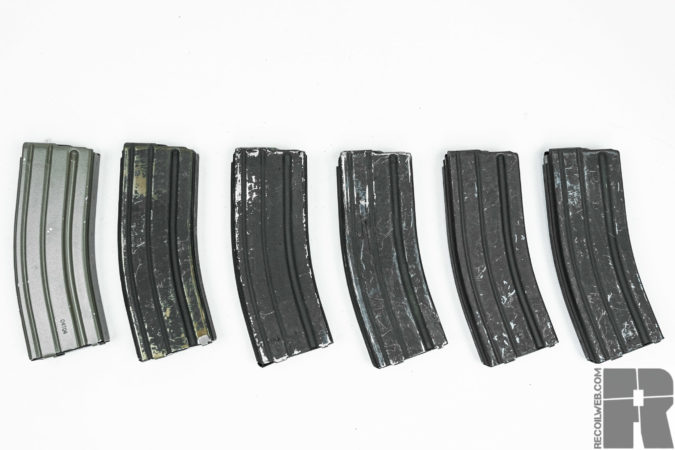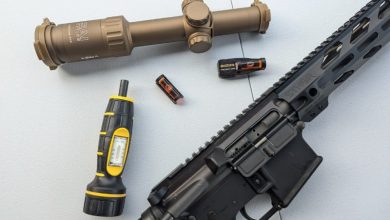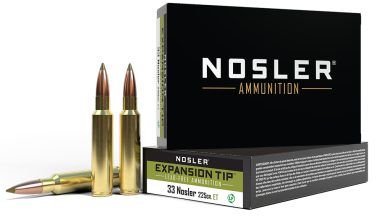PILES OF MAGAZINES TO PICK FROM, BUT WHO CAN YOU TRUST YOUR LIFE TO?
By Forrest Cooper & David Lane
Somewhere in the deepest parts of the dark web, there’s a conspiracy afoot. Sowing division and tearing families apart, the war of the AR-15 Magazine rages on, and it’s not what we think.
This isn’t the fight over what makes a high-capacity magazine, but over which one is the best.
The factions are fuzzy, sometimes blending between polymer and metal construction, other times relying on reputation and history, but the truth about what makes an excellent AR-15 Magazine has to come out, and it’s not for the faint of heart.
We concern ourselves with features such as construction, capacity, cost, and compatibility. The evaluations, however, focus on reliability over time, in harsh environments, and durability, as well as subjective matters, including aesthetic and feel.
The features can typically be gleaned from the manufacturer’s website, the evaluation, however, cannot.
WHAT MAKES A MAGAZINE “GOOD”?
First off, it needs to work. That’s mostly where it starts and ends. Magazines are always the weak point of a firearm. Without great magazines, your weapon is doomed from the start.
Beyond reliability, cost is a major factor. Having one or two magazines is never a great idea — having one or two dozen is a much better plan. Even the best magazines in the world will break eventually; that’s just how life works. Having spares is a must.
Once a magazine is reliable and reasonably priced, some extra little features can be nice to have. Windows in the side of the mag let you see how much ammo you have left, and the same can be said for witness holes in the back or side.
Brightly colored magazine followers make it easier to see when a mag is down to the last few rounds with just a glance in the mag. Different colors can also help you keep different ammo types separate if that’s your thing.
The texture of your magazine can make pulling them out of mag carriers easier, holding on to them more securely, and getting them in and out of your weapon faster.
These are all fairly minor and basically up to you to choose what you like and dislike.
Really, as long as it is dead-on reliable and at a price you can afford — the rest is gravy.
HIGH-CAPACITY VS. STANDARD-CAPACITY
Bottom line is that there is no firm definition. Really, “high-capacity” only came into being because of legislation that banned magazines that held more than X rounds.
“Standard capacity” for the AR-15 is generally 30-rounds simply because that is the most common size of magazine.
Are magazines that hold more than 30 magically “high-capacity”? It depends on who you ask. Legally, in some states, over 10-rounds is defined as “high-capacity.” In other states, over 15 is the magic number.
Both are just what anti-gunners want people to think. In my view, any AR-15 magazine under 30-rounds is a “low-capacity” magazine.
The standard is 30.
BEST AR-15 MAGAZINES
Magpul PMAG
The reigning champion of polymer AR15 magazines holds its throne, not only because it has seen war and come home to tell about it, but continues to fit both the needs of the many and the needs of the few.

Having improved their initial design to the current standard of 3rd Generation PMAGS, the list includes options for capacity and caliber-specific models.
Early to craft a 300 Blackout specific magazine, for both differentiating from mags loaded with .223/5.56 and specifically identifying feed issues specific to the caliber, Magpul continues to fit a niche, even when it has long defined a genre.
In one sense, the rise of polymer magazines partly defined the changeover from Cold War generation firearms to the newest standards. The use of plastics for grips, accessories, and so forth, continued a path of refinement and diversity, and approached AR-15 Magazines from more than one angle.

In the military, young leaders taught their newest soldiers how to inspect their magazines for bent feed lips and ritualized it, as even a small deformation would produce a failure to feed.
Instead of bending, polymer feed lips would either spring back to shape, or crack, leaving nothing to mystery.
Polymer performed in extreme environments where aluminum would shrink and expand depending on the temperature. By manufacturing AR-15 magazines through injection molding, Magpul achieved a disassemblable magazine without the bulk needed with aluminum construction.
Make no mistake, however, PMAGS are made to last, but also have a disposable element. At the same time, as a testimony to their durability, many remain in use after decades of deployments and competitive abuse.
Recently, AmmunitionToGo.com did some real-world testing on the PMAG Gen 3 with great results. Bottomline, these mags last a long time.


Daniel Defense
John Lovell of Warrior Poet Society once nearly broke the internet when he suggested that a 30-round AR-15 magazine should only be loaded to 28 or 29 rounds.
This practice originated in the military to make seating a magazine easier and more reliable on a closed bolt under stress, so it’s not surprising that when Daniel Defense came out with their own magazine, they set their capacity at 32.
Further, they took inspiration from many other magazine accessories common across military and competitive scenes with aggressive texturing and a looped baseplate.

Unlike PMAGs, Daniel Defense Magazines come in one format, and one format only. Both 300 Blackout and .223/5.56 rounds reliably cycle, which makes them a good candidate to add to an already existing stockpile to consistently differentiate between magazines loaded with the caliber.
Lancer AR-15 Magazine
Lancer Systems took the strengths of both metal and polymer magazines and combined them in order to produce a hybrid that combats the weakness of both.

The hardened steel feed lips resist distortion better than aluminum and don’t crack like polymer. The lightweight body can be molded for a better grip.
Whether for the tactical ability to check rounds or for the Instagram, or to differentiate between mags loaded with 300 Blackout or 2.23/.556, polymer has quickly become the new normal in magazine construction.

Lancer mags come with a suite of useful features. Other than having a long and constantly changing list of color options, Lancer AR-15 Magazines come in different capacities and have propriety couplers for those so inclined.
The texture resembles some chequering seen on pistol grips and provides a secure hold when cold and wet while ridges serve as round count indicators with markers at 30 and 20 rounds. Compared to a PMAG, Lancer Mags are a little thinner and slightly closer in dimension to their aluminum predecessors.
Mission First Tactical AR-15 Magazine
The latest addition to our guide comes from Mission First Tactical! With a wide range of sizes, MFT mags can fit most applications.

While they offer a few flavors like Extreme Duty, Windowed, and Translucent EXD, the one we’ve shot the most was the Translucent mags. From training sessions in the Arizona mud and dust with BRVO Tactical to the wet wilds of West Virginia at InRange TV’s Brutality match, these mags have been put through some pain.

Overall the mags work. They feed, they shoot, and they didn’t break when they were abused. They do mag things and do it well. So far, they work far better than any other translucent mag tested. Being able to see your rounds is also nice for keeping track of what mag needs to be topped off and how dirty things are getting, especially when shooting suppressed.
Small criticism is that while most 30-round AR-15 mags can have a 31st round stuffed into them if you try hard enough, the MFT mags easily accepted that extra round. But with that 31st round, the mag could not sit on a closed bolt. You should always keep an eye on your mag to make sure you’re not overloading it, but this was a little annoying since it took a bit more care to ensure it didn’t happen.

A big deal? Not at all. But something to look out for. The benefits of a translucent mag was more than enough to make up for it.
Strike Industries AR-15 Magazine
Similar to Daniel Defense Magazines, the Strike Industries AR-15 Magazine has a capacity of 32 for spring tension. Following their style, it has both aggressive texturing and a slight cyberpunk aesthetic.
It’s not all show, as the front and back of the AR-15 Magazine feature the most abrasive surface, leaving the sides slicker to avoid rubbing holes in gear or dragging during a reload.

Strike Industries took extra care in designing their feed lips, for a secure first-round chambering. Though they are a new player on the AR-15 Magazine field, it is yet to see where they will land, although the pool is large and the demand high.
A small but distinguishing feature is the thumb bump on the back spine. Acting as a reference point, it serves as a repeatable spot to index the thumb, especially when drawing from a chest rig or plate carrier.
Those familiar with efficiently reloading under Night Vision will immediately relate to this small advantage.
SPECS:
- Construction: Glass Reinforced Polymer
- Capacity: 32 rounds
- Colors: Black
- Cost: ~$17
- Compatibility: .223/5.56
TorkMag
When it comes to magazines, it isn’t often that you find a smaller shop offering a good product. TorkMag is that rare exception. After a few thousand rounds I can safely say that these are not only well-designed with novel benefits, but they actually run well also. So far, I’m at zero malfunctions with them.

TorkMag is a polymer body with a unique spring system. Instead of just the main normal spring you’re expecting, TorkMag also uses an additional roller spring for constant tension. This eliminates the need for oversized followers while still preventing the follower from tilting in any direction that may cause a malfunction.

Combined this gives you a reliable magazine that can also fit more rounds inside almost the same space, 35-rounds instead of only 30. While fractionally larger than a standard 30-round PMAG, getting 5 extra rounds is pretty nice.
TorkMag also comes in larger flavors, 40-round and 50-round. The 40 is significantly smaller than the Magpul 40-round magazine while the 50-round TorkMag starts getting a bit long. Benefit of the 50-round mag is that it fits in normal magazine holders and is a lot easier to carry if you want. It’s also a lot easier to load than a D-60 drum mag. Downside is that going prone with these extended mags isn’t fun.

For standard use, the 35-round TorkMag is solid while giving you more rounds on tap. For competition or fun at the range, the 50-round TorkMag is pretty cool.
STANAG (G.I.)
As it stands, aluminum magazines are a world of their own. Variations between companies require a little investigation to determine what the markings truly mean.

Like forged AR-15 Lowers, at some point many were made in the same factory, but that does not mean all aluminum magazines are created equal. Derived from the NATO term Standardization Agreement, STANAG pattern magazines are supposed to be able to fit and operate in any firearm designed to the specifications.

There appears, from the outset, to be two different discussions when it comes to aluminum AR-15 Magazines. First, there are the aluminum-versus-polymer wars, which occasionally resemble the old 9mm versus .45 days of yore. Within the aluminum magazine purists, however, you will find another conflict. Which manufacturers are considered worthy, and which should be avoided?

Aluminum magazines differ from polymer, in that their feed lips will bend when plastic will break. This double-edged sword renders polymer magazines disposable, while aluminum AR-15 Mags require maintenance.
With routine inspection and regular tuning, aluminum magazines can last for decades and across multiple conflicts. In contrast, however, a bent feed lip can cause malfunctions and Murphy’s Law doesn’t play fair. Those who have carried a firearm professionally have long attested to the importance of magazine maintenance.
Magpul D60
The AR-15 Drum Magazine has seen a renaissance in recent years and directly challenges the higher capacity box style magazines for capacity and reliability.

For years, capacity has always had its drawbacks, and it has long been either reliability or weight. Since much of the weight is derived from the ammunition carried, one can only make a 60-round AR-15 magazine so light.
The greater challenge of reliability includes not only adverse environments but drop tests and feeding consistencies. The Magpul D60 moves away from the box-style magazine to bring the increased reliability of a drum at the cost of size and weight.

Round after round, the Magpul D60 AR-15 Magazine continues to chew our ammunition stores and in turn, ammo budget. On top of regularly feeding .223 and 5.56 ammunition, the Magpul D60 also boasts something not always common in drum magazines: it’s user serviceable.
Magpul recommends that the drum be cleaned and lightly oiled every 1000 rounds, which, if we’re tracking that round count, speaks for itself.

There’s no way to escape the weight of a fully loaded 60-round drum. Though difficult to store on a plate carrier or belt, D60’s find their place in both defensive and competitive uses. A round count window on the rear of the drum informs the shooter when the drum is full and when ten rounds remain.
LOOSE ROUNDS
RECOIL staff tend to use a large mix of magazines and there isn’t a clear winner on what makes it into our personal belts. Magpul, USGI, and Lancer are the most common. There are a lot of good magazines on the market for the AR and what is best will depend on your goals.
For standard AR-15 use that you can always count on, Magpul for polymer and USGI for metal are safe bets.
READY FOR MORE?

NEXT STEP: Download Your Free Target Pack from RECOIL
For years, RECOIL magazine has treated its readers to a full-size (sometimes full color!) shooting target tucked into each big issue. Now we’ve compiled over 50 of our most popular targets into this one digital PDF download. From handgun drills to AR-15 practice, these 50+ targets have you covered. Print off as many as you like (ammo not included).
Get your pack of 50 Print-at-Home targets when you subscribe to the RECOIL email newsletter. We’ll send you weekly updates on guns, gear, industry news, and special offers from leading manufacturers – your guide to the firearms lifestyle.
You want this. Trust Us.
Read the full article here





